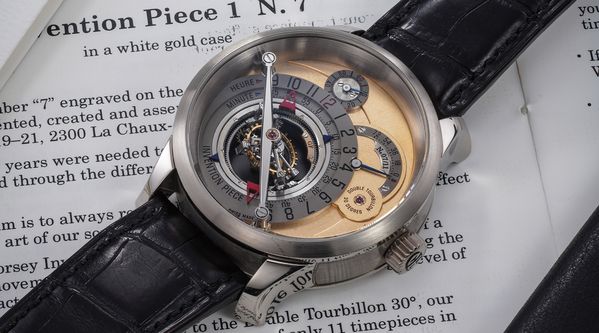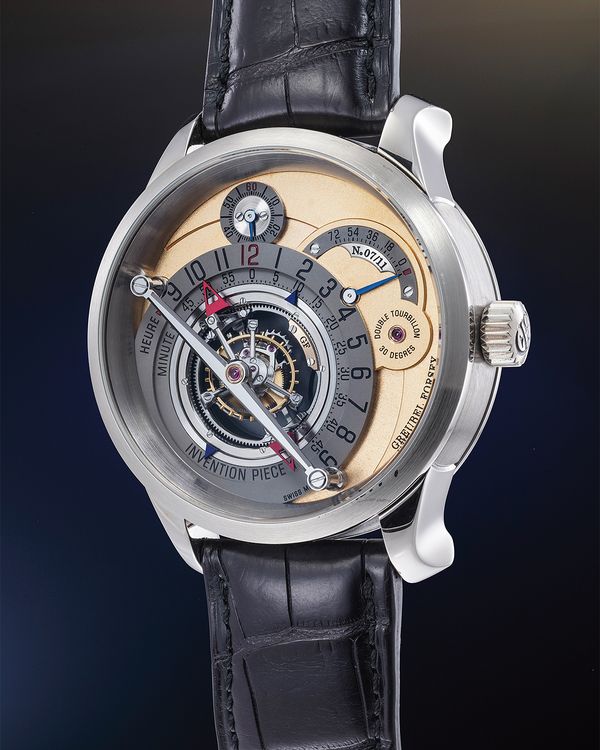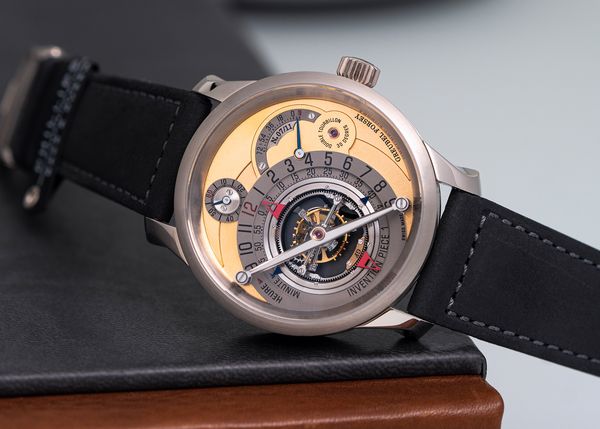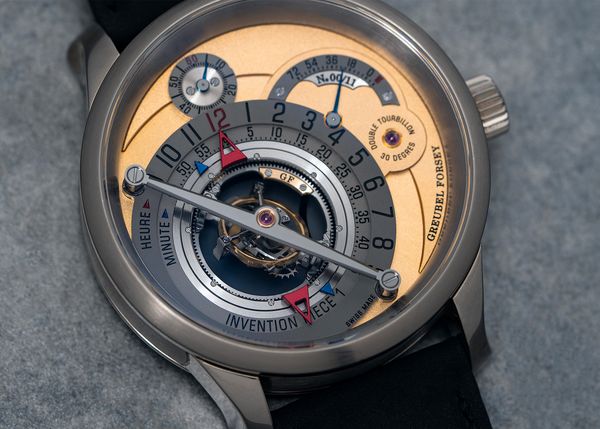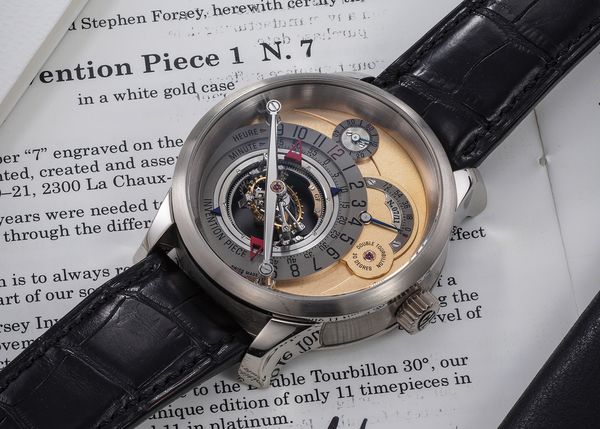Our first live auction of 2023, the PHILLIPS Geneva Watch Auction: XVII, takes place on May 13 and 14, at La Réserve Genève. The auction includes more than 200 of the world's finest watches – and though we are loath to boast, we truly think it's one of the best catalogs we've ever put together. We'll be highlighting a number of the most interesting lots and stories featured in the sale over the next month, including the 18k white gold Greubel Forsey Invention Piece 1 seen here.
– By Logan Baker
Almost exactly two months ago, my colleague Arthur Touchot and I drove from Geneva to La Chaux-de-Fonds with a video crew in order to film our two-part video series on the Naissance d’une Montre 2 project at the Greubel Forsey manufacture (see: Part One, hosted by Arthur; Part Two, hosted by yours truly).
I was excited about the trip for multiple reasons. For one thing, it was my first video project at Phillips (I joined the team in January), and for another, the Naissance d’une Montre 2 is simply a remarkable watch. However, I was also just outright giddy at the opportunity to visit the Greubel Forsey manufacture again.
I’ve been fortunate enough to visit Greubel Forsey’s facilities in La Chaux-de-Fonds a few times, and I can never get enough. The company’s headquarters is inside what must be the most interesting building in the entire Swiss watch industry. The heart of it is a 17th-century farmhouse that was purchased by company founders Robert Greubel and Stephen Forsey in 2007. The pair gradually worked through the late 2000s and early 2010s to expand the building to its current form, which features a tall, modernist, glass-walled atelier that swells off to the side of the once-quaint wooden home. Think I'm exaggerating? Take a closer look here.
The building is awesome. But the watches produced by Greubel Forsey inside it are even better, pushing technical and aesthetic boundaries in every direction possible. I can’t think of another watch company that dedicates more man hours to every watch they make than Greubel Forsey.
Greubel Forsey hits the 20-year mark in 2024, which is something worth celebrating. So before we left Geneva, I tried to refresh my memory to see if there might be any older Greubel Forsey watches I might want to see while visiting their home base. Well, it didn’t take me long before I remembered the Invention Piece 1, a watch I’ve always adored and that I view as the perfect encapsulation of everything I like best about Greubel Forsey as a brand.
Greubel Forsey, if you weren’t aware, is all about inventions. Their primary slogan is “The Art of Invention,” which might come across as banal if they didn’t back it up with sheer horological firepower. Founders Robert Greubel and Stephen Forsey basically spent the first 16 years at their business fighting against everything other brands had previously dismissed as impossible. We’re talking multi-axis tourbillons (double, even quadruple!), differentials and one-second remontoires, grand sonneries, you name it, Greubel Forsey likely experimented with it in the past two decades.
And while pretty much every successful new “invention” gets a chance to shine by being applied in a variety of watches and collections, Greubel Forsey wanted to place an even brighter spotlight on what they viewed as their most important and influential inventions. Thus, the Invention Piece series was born, consisting of small-batch runs of brand-new watch designs that would basically function as a vessel or a showcase for whichever "Fundamental Invention” was included in the movement.
Invention Piece 1, as you might be able to guess, highlights Greubel Forsey’s first Invention, the Double Tourbillion 30°. The watch was first announced in 2007, three years after the brand itself debuted, with the first Double Tourbillion 30° wristwatch as a show piece. The total production of the Invention Piece 1 was limited to exactly 33 pieces, so I didn’t expect Greubel Forsey to still have a sample laying around their office, but I figured I might as well ask.
Luck was on my side. Greubel Forsey was able to accomodate my request, and I quickly had one of the few Invention Piece 1 watches ever made sitting in front of me in between our on-camera interviews. It had been years since I had last seen one, and it was just as compelling as I remembered it to be.
As I left La Chaux-de-Fonds that day, I thought that might be the end of my Invention Piece 1 distraction, but as luck would have it, I found out a few weeks later that a white-gold example would be included in the Geneva Watch Auction: XVII catalog. Fate, clearly, was bringing the Invention Piece 1 and I closer together. And while I won't be bidding on the watch myself next month, I’ll attempt to elucidate my personal interest and appreciation for any collectors out there that might be curious about the significance of the watch.
To understand the Invention Piece 1, you first must understand the Double Tourbillion 30° mechanism by itself.
A tourbillon, of course, is a type of regulating organ that was originally invented by Abraham-Louis Breguet in the early 19th century as a way to counteract the effect of gravity on the balance of a pocket watch. It has historically been less effective on a wristwatch, simply given the fact that the influence of gravity is far more varied on a watch that's worn on the wrist rather than one that sits in the same position inside of a pocket or on a desk all day.
Greubel Forsey’s Double Tourbillion 30°, meanwhile, consists of two separate tourbillons, attached via a single escapement, with a smaller tourbillon inclined at a 30-degree angle placed inside a larger tourbillon carriage. The interior tourbillon rotates once per minute, while the larger tourbillon completes a rotation once every four minutes. The theory is that the angle of the inner tourbillon combined with the simultaneous-yet-separate rotations of the two tourbillons is enough to impede any effective forces of gravity that an individual might place on their wristwatch as they’re moving around and going about their day.
A lot of technical watchmaking these days is built around concepts that might barely improve or impact the performance or precision of a wristwatch. Or they might not at all. It’s typically difficult to receive quantifiable data on a watch worn in the wild for any significant period of time. Greubel Forsey, however, wanted to prove to the public that their Double Tourbillion 30° was more than just a concept and actually made a difference in rate stability and precision.
A few years after the debut of the Double Tourbillion 30°, Greubel Forsey entered an example of the watch into the Concours International de Chronométrie, a chronometry competition. Greubel Forsey not only walked away from the trial with the top prize, but they also set an all-time record, earning 915 out of the 1,000 total points, with an average rate between +0.3 and +0.8 seconds per day during the entire competition.
The development, creation, and success of the Double Tourbillion 30° is a major reason why Greubel Forsey still exists today. It’s why they have that big, beautiful building in La Chaux-de-Fonds, and why they’re able to help sponsor important projects like Naissance d’une Montre 2. As incredible as so many Greubel Forsey watches are, I definitely have a special affinity for models that incorporate the Double Tourbillion 30° – and the king of all those references is without a doubt the Invention Piece 1.
I mean, the whole purpose – the entire existence – of this watch was to best showcase Greubel Forsey’s most important innovation. How can you not love it? The Double Tourbillion 30° inside the Invention Piece 1 effectively acts as the center of the solar system, with every other element surrounding it. Even the time display itself is concentrically geared directly off the tourbillon!
The Greubel Forsey Invention Piece 1 was created in a run of 33 watches, with 11 pieces each in 18k white gold, 18k yellow gold, and platinum. Time is indicated via the retrograde-style semi-circle that consists of two layers, one for hours and another for minutes. The larger red triangle hand indicates the hours, and the shorter blue hand shows the minutes. A running seconds sub-dial is included directly above the tourbillon and timekeeping displays, and a 72-hour power reserve display is positioned slightly to its right. The individual model number (XX/11) is engraved on a plate tucked underneath the power reserve.
Although the timekeeping format is a bit on the funky side, I’ve always felt it to be fairly intuitive. The 12-hour and zero-minute markers are aligned at the traditional 12 o'clock position to make things easier. More importantly, it allows the Double Tourbillion 30° to remain at the center of attention, as you’ll never be able to check the time without staring directly at it.
I also want to make a note of the black-polished tourbillon bridge that hovers across almost the full diameter of the dial. The polishing is, as you’d expect from Greubel Forsey, flawless, but it's the sheer size and scope of the bridge that I find to be utterly remarkable. I wouldn’t be surprised at all if this is the single largest black-polished movement component in all of Swiss watchmaking. I'd love to be proven wrong. I even saw a passing mention somewhere that it takes a single Greubel Forsey employee up to 24 hours to finish polishing the entire bridge of the Invention Piece 1 – that’s three full days of work, assuming a conventional eight-hour workday. And in case you're wondering, the watch's movement is made up of of 388 total components, with the twin tourbillon cages taking up 128 of that total. The entire double cage architecture weighs just 1.17 grams.
Turn the watch over, and the caseback is executed in the classic Greubel Forsey style, which means there's a full-blown 200-word French novel engraved in relief on the caseback that explains the company’s philosophy and its intentions. I know a lot of collectors (and internet commenters) don’t love it when Greubel Forsey does this, but I can’t help but be impressed at how difficult it must be to hand-engrave each of those tiny letters and words without introducing any errors. Any mistake, and you'd have to start over from scratch. There's no spellcheck when you’re carving something into metal.
The three different case material variations all included other slight aesthetic tweaks throughout. The 18k white gold example is likely the most recognizable, as it pairs the cool tone of the case metal with the warmth of a frosted gold dial. Yes, the dial is actual gold that’s undergone a frosted finish; it's not color-treated brass or something else. The 18k pink gold and platinum case variants, meanwhile, received a fairly similar frosted silver-tone finish on the dial. The platinum plays with a tone-on-tone aesthetic a little bit, while the pink gold basically inverts the colorway of the white gold version.
I’ve been told that the 18k white gold example is the most sought-after by collectors, but given how rare the Invention Piece 1 is as a whole, I feel like it’s hard to go wrong no matter what case and dial configuration you select. According to my research, we’ve seen 12 of the 33 examples come up for public sale over the past 16 years, including seven appearing at auction. (Phillips has sold just one previous Invention Piece 1, a platinum example, in 2016.)
Despite (or maybe because of) its popularity, the white gold variation has seen the most examples come up on the secondary market, with six different versions becoming available at some point (including the upcoming Geneva Watch Auction: XVII lot), compared to just three appearances each for the platinum and the pink gold.
One of those platinum models actually has a pretty cool backstory. It appears that Jean-Claude Biver himself had a unique platinum Invention Piece 1 made that was inscribed “JCB” on the plate that would typically indicate the model number. It’s also been reported in the past that – at least at one point in time – the Invention Piece 1 was the daily watch of choice for Robert Greubel as well as Stephen Forsey’s personal favorite Greubel Forsey creation.
The Greubel Forsey Invention Piece 1 turns 16 this year, and it’s remarkable how fresh and current it still looks today, despite countless changes in the tastes of collectors. I think that’s overall a positive thing – especially for a watch that retailed for plus-or-minus CHF $500,000 when it was released.
Almost two decades later, no watchmaker has even come close to approaching Greubel Forsey in the pace of their development pace and the quality of each of their new technical inventions. While I don’t have the faintest idea of what Greubel Forsey has planned for the future, when I look at the Invention Piece 1, I can’t help but think there’s countless more exciting things to come down the road.
Even so, I doubt they’ll ever have the same emotional significance as the Invention Piece 1.
You can learn more about and register to bid on the Greubel Forsey Invention Piece 1 by visiting the online catalog for PHILLIPS Geneva Watch Auction: XVII.
About Phillips In Association With Bacs & Russo
The team of specialists at PHILLIPS Watches is dedicated to an uncompromised approach to quality, transparency, and client service. Phillips in Association with Bacs & Russo holds the world record for the most successful watch auction, with its Geneva Watch Auction: XIV having realized $74.5 million in 2021. Over the course of 2021 and 2022, the company sold 100% of the watches offered, a first in the industry, resulting in the highest annual total in history across all the auction houses at $227 million.
About Logan Baker
Logan has spent the past decade working in watch-focused media, reporting on every aspect of the industry. He joined Phillips in Association with Bacs & Russo at the start of 2023 as the department's Senior Editorial Manager. He splits his time between New York and Geneva.
Recommended Reading
Naissance d’Une Montre 2: Making A Watch By Hand In The 21st Century (Video)
Independent Watchmakers: The Bridge Between Vintage And Modern Collectibles
